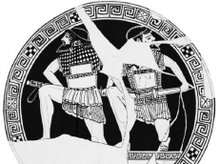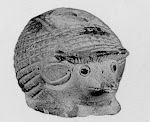The biggest objections to othismos dissapear when you accept my definition of othismos only occuring at crowd-like densities and understand how crowds push:
"Battles were long, men can't push that long."
The crowd cannot do anything fast. As soon as it starts to advance it begins to lose cohesion. Once this occurs it cannot transfer force through the ranks effectively. That is not to say "pushing" stops, but by my definition, the type of pushing done by the first few ranks with not transfer of force from deep in the file is not true "othismos", but the same shield bashing and pushing seen in a clash of any group of close-in fighters such as during Roman battles. For the most part in the Crowd-Othismos men are simply standing and leaning. It is exhausting, perhaps moreso mentally than physically, but no more than active weapons duelling. The phalanx does not advance like a steam roller, but like a ratchet, with perdiodic loosening and tightening of the ranks. When a rapid advance does occur, like it must have as one side gave way, it was only the front ranks pushing and even they were doing more "herding" like we see with riot police and crowds, than pushing in the sense of othismos.
An advance in true othismos can only occur through shuffling steps until one side gives way. As they begin to rout, they reduce the pressure on their foes that the othismos-crowd requires.
"Men can't fight and push"
When authors envisioned men bent over like rugby scrummers I could understand this objection. In the Crowd-Othismos, men are standing upright, and but for the extreme close range, their right arms are free to do whatever they wish with them. Obviously at this range you cannot use your dory against the man ahead of you, but the dory is some 8' long, not an Iklwa. It could not be used at any range approaching shield on shield contact. Swords, broken spears, fists, foot-stomps/hooks and teeth would be the order of the day.
"Twelve ranks of Spartans could not resist 50 ranks of Thebans for more than a few moments and yet we know that this phase of battle lasted for some time, with the Spartans even gaining ground to pick up their fallen King."
Not a problem when we understand that coordination of the crowds movements is what adds force in the othismos. There is only so much coordination you can get out of a file of 50 men. Even with a deep phalanx you probably can't get much more than 8-12 ranks perfectly coordinated. Thus, each side produces a forward thrust of about the same size at any given moment. As we wrote above, the depth acts like a wall behind your back. If you are pushed back, it forces all your ranks to tighten and become de facto coordinated to resist being moved. Twelve ranks of Spartans could push back the Thebans, but at a great disadvantage. The figurative "uphill battle" could only end one way.
I'll note that my distinction of pushing at different densities, with othimos only occurring at the tightest packed is not something that the Greeks would have made. They only speak of battles coming down to pushing, they did not disect the process and probably did not undertand it any better than a college kid rushing a stage at a rock concert. To them the whole process was one event.
Tuesday, May 4, 2010
Subscribe to:
Post Comments (Atom)





4 comments:
Not picking a fight, or anything, but I am curious if you have read Victor Davis Hanson's "The Western Way of War"? His arguments and support for them seem rather convincing that Othismos did occur with people purposely pushing the guy in front of them. al
Hey Al,
I'm not sure where you got the idea that what I'm describing is not purposely pushing. The problem with Hanson and others is that they do not describe, or seemingly understand, how some 8 ranks of men can effectively push together. Go back through the posts on this site and you will understand that what I am doing is explaining how hoplites intentionally pushed the men in front of them. One outgrowth of a true understanding of the way men have to form in order to transfer pushing force from the last rank to the first is that the whole notion of charging directly into othismos must be abandoned. Or perhaps to put it more clearly, a phalanx that charged right into its opposite, then pushed standing sideways, as described by Hanson would be out-pushed by one that packed in tight and pushed as I describe here.
The beauty of the Crowd-Othismos model presented on this site is that it provides for a much stronger pushing othismos that actually includes all ranks (when analyzed, Hanson's cannot) but still allows for a period of spear-fencing preceeding it. I believe this is the answer to the long-fought othismos debate.
Thanks for your comment, and feel free to ask me to explain any of the details.
IIRC, the Spartans were originally "winning" (ie pushing back the Thebans) the battle at Leuctra because Pelopidas charged the Spartans on the "spur of the moment" w/ the sacred band (which I think formed the first four ranks of the deep Theban phalanx - I know this is highly debatable) to catch & pin the Spartans in a formation change, presumably to flank the deep Theban formation. Hence the Thebans (four deep) would have been pushed back by the Spartans (twelve deep) until the rest of the Theban phalanx caught up to and formed behind the sacred band for the othismos.
Hey Dan,
I agree that the Sacred Band hit the Spartan line early and probably charged right into the Spartan Hippies and the men around the King. Whether they were four deep is debatable. We see at Tegyra that they are specifically not used as a cutting edge for lesser hoplites, but banded together to form a single elite unit that punched through the Spartan phalanx. I think it likely that at Leuktra we saw the thebans attempting to "crush the head of the snake" and bring their elite hoplites up against the Hippeis and the men around the Spartan King.
That Pelopidas charged early is no suprise in this context because he saw that the elite Spartan formation was disrupted by the cavalry and the attempt at a flanking move by the Spartans.
That being said, I don't think the Spartans were winning only up until the rest of the Theban phalanx came up in support of the Sacred Band. Xenophon is a bit vague, but Diodorus makes it clear that the battle over the King's body occurs in opposition to the great weight of the Theban deep phalanx.
"Diodorus Siculus LV. 3] When the trumpets on both sides sounded the charge and the armies simultaneously with the first onset raised the battle-cry, the Lacedaemonians attacked both wings with their phalanx in crescent formation, while the Boeotians retreated on one wing, but on the other engaged the enemy in double-quick time. [4] As they met in hand-to-hand combat, at first both fought ardently and the battle was evenly poised; shortly, however, as Epameinondas' men began to derive advantage from their valour and the denseness of their lines, many Peloponnesians began to fall. For they were unable to endure the weight of the courageous fighting of the elite corps; of those who had resisted some fell and others were wounded, taking all the blows in front. [5] Now as long as King Cleombrotus of the Lacedaemonians was alive and had with him many comrades-in-arms who were quite ready to die in his defence, it was uncertain which way the scales of victory inclined; but when, though he shrank from no danger, he proved unable to bear down his opponents, and perished in an heroic resistance after sustaining many wounds, then, as masses of men thronged about his body, there was piled up a great mound of corpses.
LVI. There being no one in command of the wing, the heavy column led by Epameinondas bore down upon the Lacedaemonians, and at first by sheer force caused the line of the enemy to buckle somewhat; then, however, the Lacedaemonians, fighting gallantly about their king, got possession of his body, but were not strong enough to achieve victory. [2] For as the corps of elite outdid them in feats of courage, and the valour and exhortations of Epameinondas contributed greatly to its prowess, the Lacedaemonians were with great difficulty forced back; at first, as they gave ground they would not break their formation, but finally, as many fell and the commander who would have rallied them had died, the army turned and fled in utter rout."
By this time the Sacred Band was almost the equal of the Hippeis in battle- and eager to show it-but I don't think we need conjecture a shallower formation to see the type of back and forth mentioned by Xenophon. The Hippeis were still the paramount hoplites in Greece.
The Sacred band with the deep Theban column combined was unstoppable in a head-on clash, but as I have noted before this was not a steam-roller, pushing in such crowds takes time and is a slow, racheting process that can allow periods of back and forth.
Post a Comment